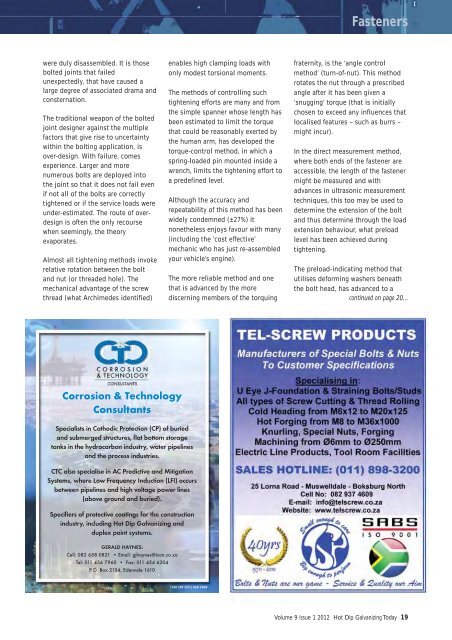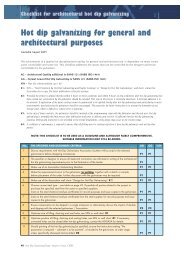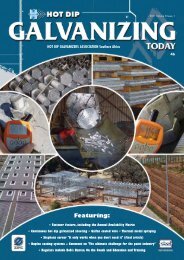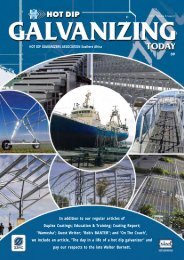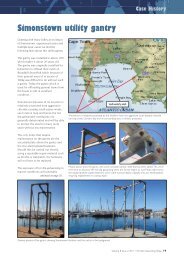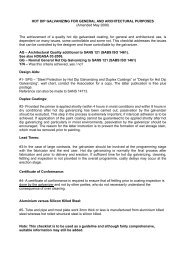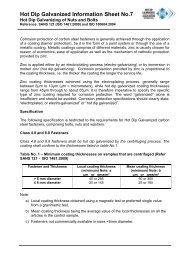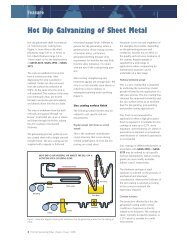Fasteners - hdgasa
Fasteners - hdgasa
Fasteners - hdgasa
You also want an ePaper? Increase the reach of your titles
YUMPU automatically turns print PDFs into web optimized ePapers that Google loves.
<strong>Fasteners</strong><br />
were duly disassembled. It is those<br />
bolted joints that failed<br />
unexpectedly, that have caused a<br />
large degree of associated drama and<br />
consternation.<br />
The traditional weapon of the bolted<br />
joint designer against the multiple<br />
factors that give rise to uncertainty<br />
within the bolting application, is<br />
over-design. With failure, comes<br />
experience. Larger and more<br />
numerous bolts are deployed into<br />
the joint so that it does not fail even<br />
if not all of the bolts are correctly<br />
tightened or if the service loads were<br />
under-estimated. The route of overdesign<br />
is often the only recourse<br />
when seemingly, the theory<br />
evaporates.<br />
Almost all tightening methods invoke<br />
relative rotation between the bolt<br />
and nut (or threaded hole). The<br />
mechanical advantage of the screw<br />
thread (what Archimedes identified)<br />
enables high clamping loads with<br />
only modest torsional moments.<br />
The methods of controlling such<br />
tightening efforts are many and from<br />
the simple spanner whose length has<br />
been estimated to limit the torque<br />
that could be reasonably exerted by<br />
the human arm, has developed the<br />
torque-control method, in which a<br />
spring-loaded pin mounted inside a<br />
wrench, limits the tightening effort to<br />
a predefined level.<br />
Although the accuracy and<br />
repeatability of this method has been<br />
widely condemned (±27%) it<br />
nonetheless enjoys favour with many<br />
(including the ‘cost effective’<br />
mechanic who has just re-assembled<br />
your vehicle’s engine).<br />
The more reliable method and one<br />
that is advanced by the more<br />
discerning members of the torquing<br />
fraternity, is the ‘angle control<br />
method’ (turn-of-nut). This method<br />
rotates the nut through a prescribed<br />
angle after it has been given a<br />
‘snugging’ torque (that is initially<br />
chosen to exceed any influences that<br />
localised features – such as burrs –<br />
might incur).<br />
In the direct measurement method,<br />
where both ends of the fastener are<br />
accessible, the length of the fastener<br />
might be measured and with<br />
advances in ultrasonic measurement<br />
techniques, this too may be used to<br />
determine the extension of the bolt<br />
and thus determine through the load<br />
extension behaviour, what preload<br />
level has been achieved during<br />
tightening.<br />
The preload-indicating method that<br />
utilises deforming washers beneath<br />
the bolt head, has advanced to a<br />
continued on page 20...<br />
Corrosion & Technology<br />
Consultants<br />
Specialists in Cathodic Protection (CP) of buried<br />
and submerged structures, flat bottom storage<br />
tanks in the hydrocarbon industry, water pipelines<br />
and the process industries.<br />
CTC also specialise in AC Predictive and Mitigation<br />
Systems, where Low Frequency Induction (LFI) occurs<br />
between pipelines and high voltage power lines<br />
(above ground and buried).<br />
Specifiers of protective coatings for the construction<br />
industry, including Hot Dip Galvanizing and<br />
duplex paint systems.<br />
GERALD HAYNES:<br />
Cell: 082 658 0821 • Email: gjhaynes@icon.co.za<br />
Tel: 011 456 7960 • Fax: 011 454 6304<br />
P.O. Box 2154, Edenvale 1610<br />
1160 CBT (011) 868 3408<br />
Volume 9 Issue 1 2012 Hot Dip Galvanizing Today 19


